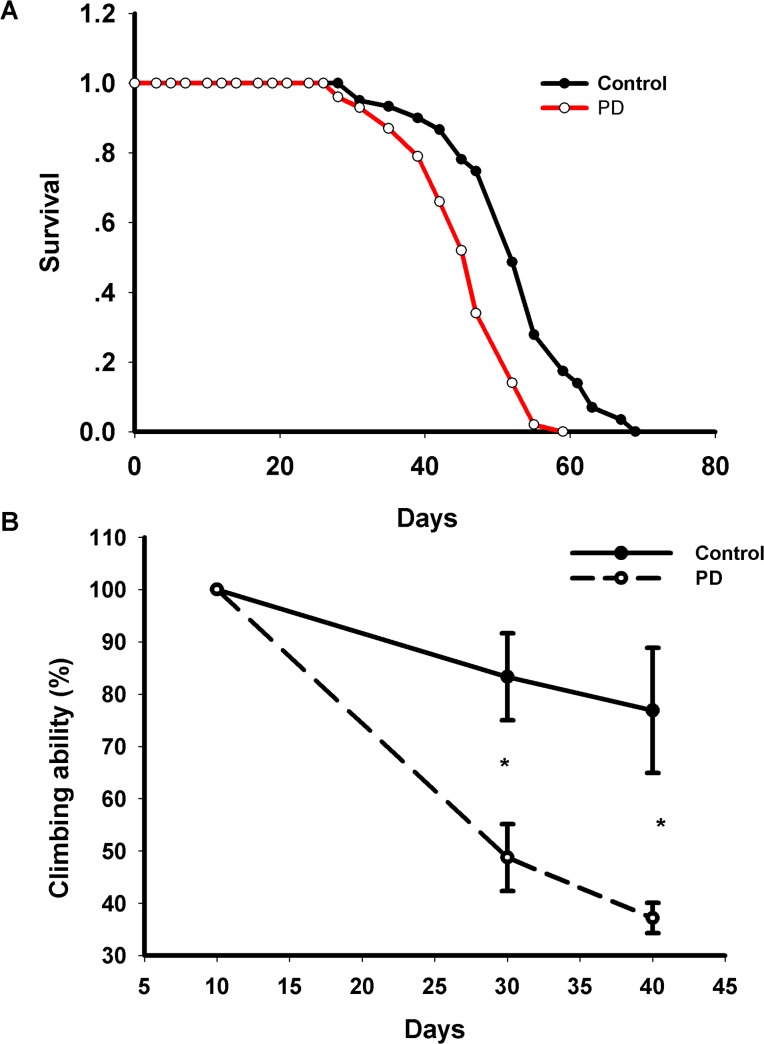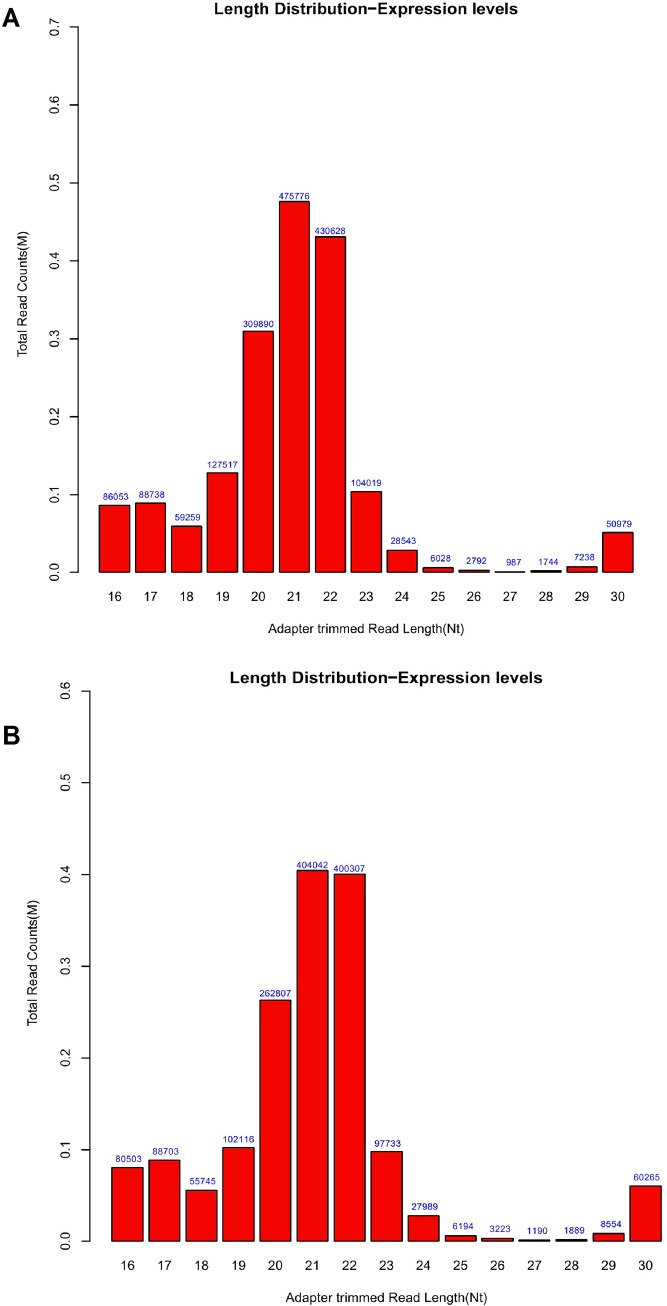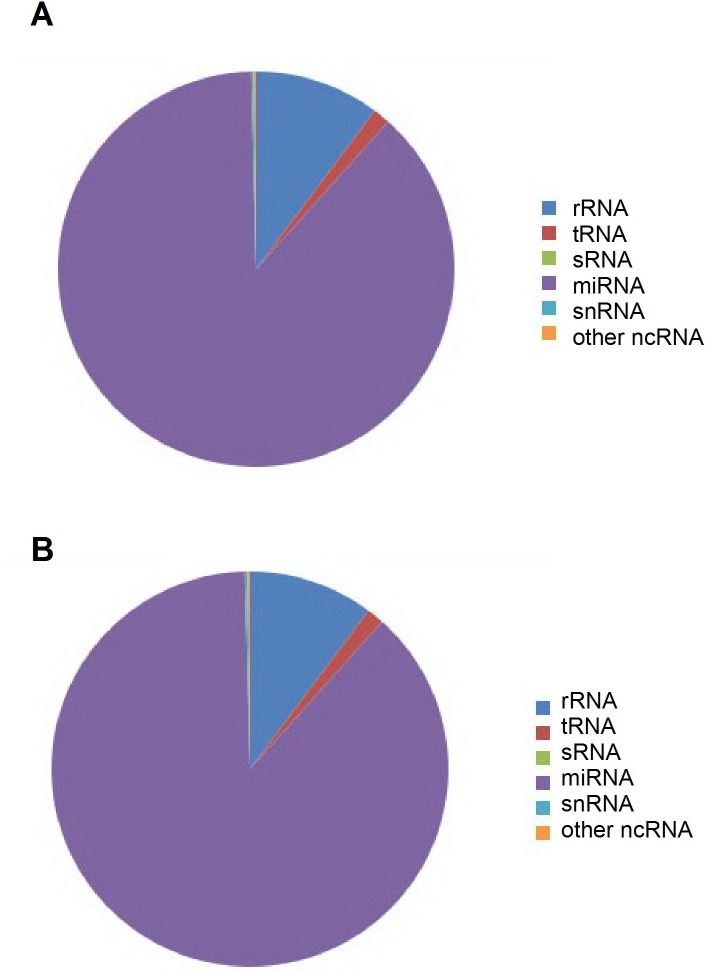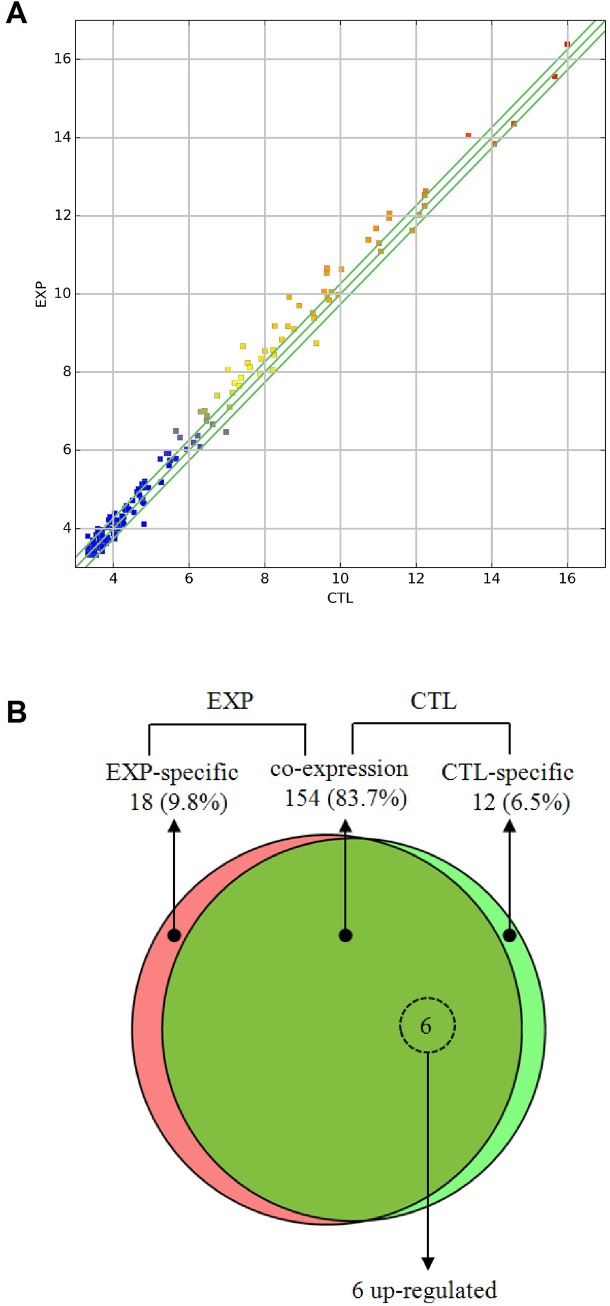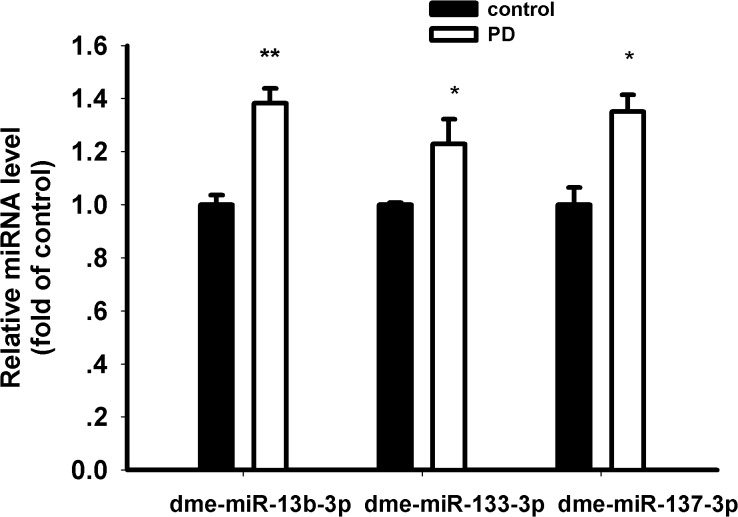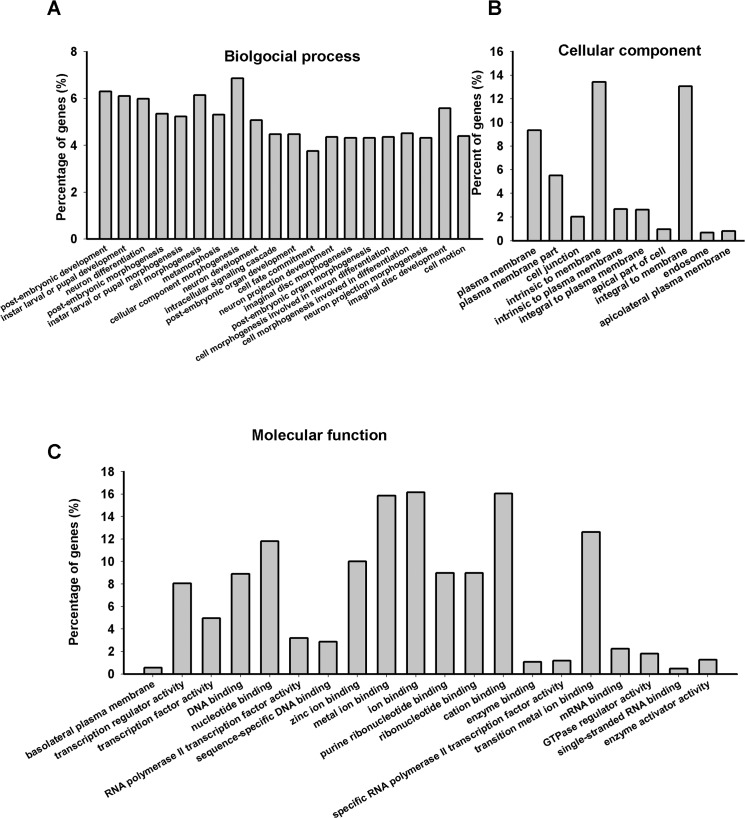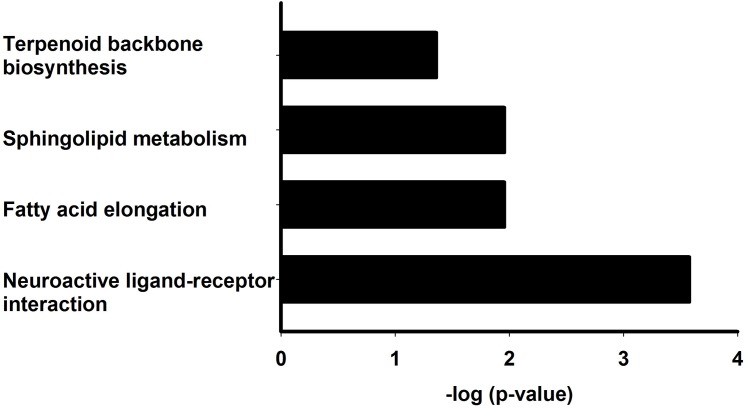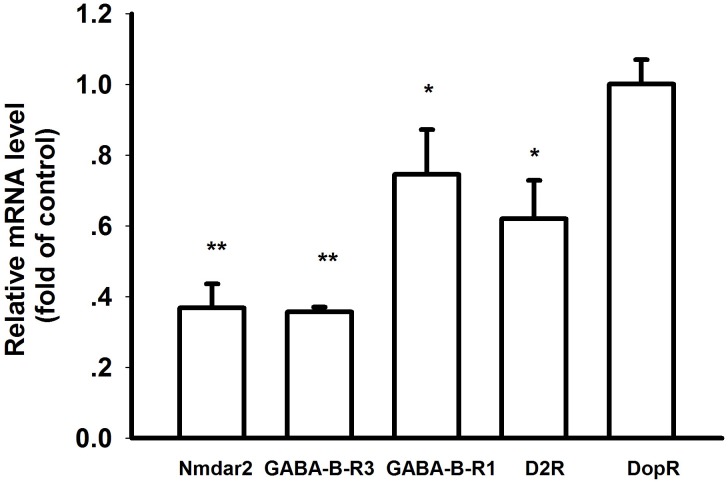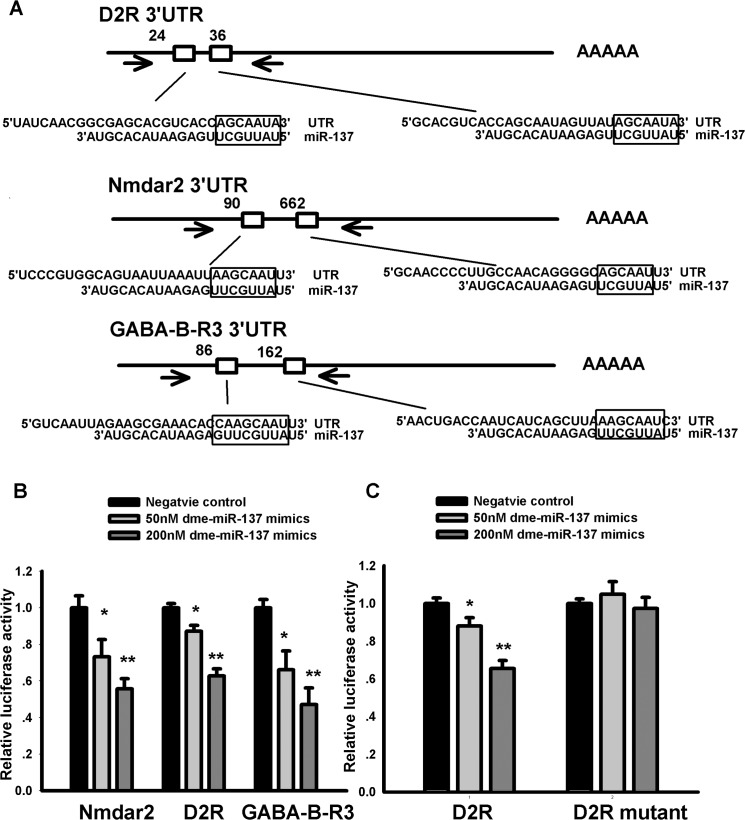Abstract
Parkinson’s disease (PD) is a prevalent neurodegenerative disorder with pathological features including death of dopaminergic neurons in the substantia nigra and intraneuronal accumulations of Lewy bodies. As the main component of Lewy bodies, α-synuclein is implicated in PD pathogenesis by aggregation into insoluble filaments. However, the detailed mechanisms underlying α-synuclein induced neurotoxicity in PD are still elusive. MicroRNAs are ~20nt small RNA molecules that fine-tune gene expression at posttranscriptional level. A plethora of miRNAs have been found to be dysregulated in the brain and blood cells of PD patients. Nevertheless, the detailed mechanisms and their in vivo functions in PD still need further investigation. By using Drosophila PD model expressing α-synuclein A30P, we examined brain miRNA expression with high-throughput small RNA sequencing technology. We found that five miRNAs (dme-miR-133-3p, dme-miR-137-3p, dme-miR-13b-3p, dme-miR-932-5p, dme-miR-1008-5p) were upregulated in PD flies. Among them, miR-13b, miR-133, miR-137 are brain enriched and highly conserved from Drosophila to humans. KEGG pathway analysis using DIANA miR-Path demonstrated that neuroactive-ligand receptor interaction pathway was most likely affected by these miRNAs. Interestingly, miR-137 was predicted to regulate most of the identified targets in this pathway, including dopamine receptor (DopR, D2R), γ-aminobutyric acid (GABA) receptor (GABA-B-R1, GABA-B-R3) and N-methyl-D-aspartate (NMDA) receptor (Nmdar2). The validation experiments showed that the expression of miR-137 and its targets was negatively correlated in PD flies. Further experiments using luciferase reporter assay confirmed that miR-137 could act on specific sites in 3’ UTR region of D2R, Nmdar2 and GABA-B-R3, which downregulated significantly in PD flies. Collectively, our findings indicate that α-synuclein could induce the dysregulation of miRNAs, which target neuroactive ligand-receptor interaction pathway in vivo. We believe it will help us further understand the contribution of miRNAs to α-synuclein neurotoxicity and provide new insights into the pathogenesis driving PD.
Introduction
Parkinson’s disease (PD) is the second most prevalent neurodegenerative disorder affecting the elderly population [1]. Its predominant pathological features are death of dopaminergic (DA) neurons in the substantia nigra pars compacta and intraneuronal accumulations of Lewy bodies [2]. As the main component of Lewy bodies, α-synuclein contributes to PD by aggregation into insoluble filaments. Multiplication of α-synuclein or mutations such as A53T, A30P and E46K were found in familial forms PD patients [3–5].However, the detailed mechanisms underlying α-synuclein induced neurotoxicity in PD still need further investigation.
PD animal models have been established by ectopic expression of human α-synuclein in yeast, Caenorhabditis elegans, Drosophila melanogaster, rat, mouse, and non-human primates [6–11]. Drosophila models have been widely used to study neurodegenerative diseases including Alzheimer’s disease (AD), Huntington’s disease (HD) and PD [8, 12, 13]. In addition to the advantages of short lifespan and convenience for genetic manipulation, Drosophila conceives complicated central and peripheral nervous systems which are analogous to those of human. Panneuronal expression of human wild type and mutant α-synuclein (A53T and A30P) demonstrate adult onset PD pathological features including DA neuronal loss, decreased dopamine level, impaired locomotive ability and shortened lifespan [8, 14, 15]. Drosophila models provide efficient tools for screening genes participate in PD and potential drugs against PD.
MicroRNAs are ~20nt small RNA molecules that fine-tune gene expression at posttranscriptional level [16]. They usually bind to 3’UTR of target mRNA and lead to translational inhibition or target degradation. It is estimated that more than half of human genes are regulated by miRNAs and the regulatory mechanisms are highly conserved among invertebrates and vertebrates. Since the discovery in 1990s, miRNAs have been found to exert essential roles in development, homeostasis and diseases. A plethora of miRNAs have been found to be dysregulated in the brain and blood of PD patients [17–20]. However, the underlying mechanisms and their functions in PD are still elusive.
In the present study, we examined the expression of miRNAs in a PD Drosophila model expressing α-synuclein by high throughput small RNA sequencing technology. We found that five miRNAs (dme-miR-133-3p, dme-miR-137-3p, dme-miR-13b-3p, dme-miR-932-5p, dme-miR-1008-5p) were upregulated in PD flies. Among them, miR-13b, miR-133, miR-137 are brain enriched and highly conserved from Drosophila to Homo sapiens. Validation experiment using qRT-PCR confirmed that these miRNAs were elevated in PD flies. KEGG pathway analysis indicated that neuroactive-ligand receptor interaction pathway was most likely affected by these miRNAs. Further studies showed miR-137 targeted multiple molecules in this pathway as predicted, including dopamine receptor (DopR, D2R), GABA receptor (GABA-B-R1, GABA-B-R3) and NMDA receptor (Nmdar2). The mRNA levels of these molecules were significantly decreased in PD flies. Our findings indicated that α-synuclein could induce the dysregulation of miRNAs, which target neuroactive ligand receptor interaction pathway in vivo.
Materials and Methods
Fly stocks and maintenance
The elav-C155 and UAS- α-synuclein flies were obtained from Bloomington Stock Center (Indiana University, USA). Flies were raised in standard yeast agar food at 25°C with a 12/12 hours light/dark cycle. After backcrossing with w 118 flies for 6 generations, elav-C155 virgin flies were crossed with w 118 or UAS- α-synuclein A30P males. The F1 generation offspring expressed α-synuclein in panneuronal manner and were used for further experiments.
Lifespan analyses
Two days after the eclosion, mated males and females were discriminated and transferred to different vials. Each vial contained 10 flies and at least 100 in total for each group. The vials were changed 3 times a week and deaths were recorded. Data was presented as survival curves and analysis was performed using log-rank tests to compare between groups.
Climbing assay
In order to characterize behavior defects in PD flies, climbing assay was performed as described previously [8]. Briefly, twenty male flies were transferred into an empty plastic vial and gently tapped to the bottom. The numbers of flies that could climb to the top (above 8cm) or remained at bottom in 18 seconds were recorded. The climbing assay was performed at least 3 times for every vial at each time point.
High throughput sequencing for miRNAs
Total RNA of each sample (three biological repeats for PD and control fly heads) was used to prepare the miRNA sequencing library through following steps: 1) 3'-adapter ligation with T4 RNA ligase; 2) 5'-adapter ligation with T4 RNA ligase; 3) cDNA synthesis with RT primer; 4) PCR amplification; 5) extraction and purification of ~125–145 bp PCR amplified fragments (correspond to ~15–35 nt small RNAs) from the PAGE gel. After the completed libraries were quantified with Agilent 2100 Bioanalyzer, the DNA fragments in the libraries were denatured with 0.1M NaOH to generate single-stranded DNA molecules, captured on Illumina flow cells, amplified in situ and finally sequenced for 36 cycles on Illumina HiSeq2000 according to the manufacturer’s instruction. Raw sequences were generated as clean reads from Illumina HiSeq by real-time base calling and quality filtering. Subsequently, the 3’ adapter sequence was trimmed from the clean reads and the reads with lengths shorter than 15 nt were discarded. As the 5’-adaptor was also used as the sequencing primer site, the 5’-adaptor sequence is not present in the sequencing reads. The trimmed reads (length ≥ 15 nt) were aligned to the fly pre-miRNA in miRBase 21, using novoalign software. The miRNA expression levels were measured and normalized as transcripts per million of total aligned miRNA reads (TPM). When comparing profile differences two groups of samples (PD and Control), the “fold change” (i.e. the ratio of the group averages) and p-value were caculated. miRNAs having fold changes ≥ 1.2, P-value ≤0.05 or fold change ≥ 2.0 were selected as the differentially expressed miRNAs.
qRT-PCR for miRNA
Quantitative real-time PCR (qRT-PCR) analysis was performed to validate the differently expressed mRNA in PD flies. Fist strand cDNA was sysnthesized using M-MLV reverse transcriptase (Epicentre) according to manufacture’s instructions. The sequences of RT primers are: 5’-GATTTTGCGTGTCATCCTTG-3’ (U6); 5’-GTCGTATCCAGTGCGTGTCGTGGAGTCGGCAATTGCACTGGATACGACACAGCTG-3’ (dme-miR-133-3p); 5’-GTCGTATCCAGTGCGTGTCGTGGAGTCGGCAATTGCACTGGATACGACCTACGT-3’ (dme-miR-137-3p); 5’-GTCGTATCCAGTGCGTGTCGTGGAGTCGGCAATTGCACTGGATACGACACTCGT-3’(dme-miR-13b-3p). qPCR reaction was performed with 2×SYBR Green PCR Master Mix (Arraystar) and ViiA 7 Real-time PCR System (Applied Biosystems) with the program: 95°C for 10 min to denature DNA templates, followed by 40 cycles of 95°C for 15 s, 60°C for 60s.PCR primers for miRNAs and U6 were listed in S1 Table.
miRNA Targets Prediction and Pathway Enrichment Analysis
The target genes of differentially expressed miRNAs were predicted by miRanda-mirSVR algorithm and then subjected to GO analysis using Database for Annotation, Visualization and Integrated Discovery (DAVID) (count cutoff 10, EASE 0.01). The significantly affected GO terms (p<0.05) in biological process, cellular component and molecular function were identified.
DIANA-miRPath is an efficient tool for analyzing the combinatorial effect of microRNAs on target pathways. We uploaded the dysregulated miRNAs and predicted potential target pathways using DIANA-microT-CDS algorithm. The significantly influenced pathways (p<0.05) were identified.
Validation of target mRNA Expression
In order to validate the expression of predicted targets for dysregulated miRNAs, qRT-PCR was performed according to previously reported methods as mentioned before. PCR primers for mRNAs were listed in S2 Table.
Luciferase Reporter Assay
The 3’UTR fragments flanking miR-137 targeting sites of Nmdar2, D2R and GABA-B-R3 were cloned from Drosophila cDNA library and inserted into pGL3-promoter vectors respectively. Each of these vectors was co-transfected with Renilla plasmid pRL-TK and dme-miR-137-3p mimics (Genepharma, Shanghai) into HEK 293 cells in 12-well plates using Lipofactamine 2000 (Invitrogen). 24 hours post-transfection, luciferase activity was measured with Dual-Glo (Promega) according to the manufacturer's instructions. PCR primers for amplification were listed in S3 Table. Mutant constructs were made by site-directed mutagenesis to replace seed sequence with BglII cleavage site.
Statistics
Log-rank tests were performed to compare lifespan between groups. For other experiments, the significance of the difference was analyzed with Student’s t test using GraphPad Prism software, and p <0.05 were considered statistically significant.
Results
Characterization of PD Drosophila models
We establised PD fly models according to literatures [8, 14, 15]. Briefly, elav-Gal4 flies were crossedwith UAS-α synuclein (A30P) to ectopically express human α synuclein in nervous systems. As reported previously, we found that PD flies exhibited shorter lifespan (Fig 1A) and impaired locomotive ability (Fig 1B) compared with control flies. These results indicated that Drosophila models successfully developed adult-onset PD like phenotype in age dependent manner. Climbing ability of PD Drosophila was comparable with control flies at day 10 post eclosion (Fig 1B), which was consistent with the results from Feany et al [8]. At this time point, loss of dopaminergic cells in PD Drosophila was also detected. Therefore, we chose day 10 flies post eclosion as early PD stage to investigate miRNA expression profiles.
Fig 1. α-synuclein-induced locomotion defects and shortened lifespan.
(A) Expression of A30P α-synuclein specifically in the nervous system shortened lifespan. Survival curves were compared using the log-rank test (P<0.01 between elav>w 1118 and elav>α-synuclein A30P flies). (B) There is no difference for climbing ability for flies expressing A30P α-synuclein and control genotype at day 10. In contrast, PD flies showed significant age dependent locomotive impairments at days 30 and 40 (*P<0.05). Control flies: elav>w 1118; PD flies: elav>α-synuclein (A30P).
Deep sequencing data analysis and verification
The miRNA samples from heads of control and PD flies were sequenced using Illumina HiSeq2000 platform. The total numbers of the reads at the sequencing data processing stages are listed for each sample (3 biological repeats for control and PD flies) in Table 1. The majority of small RNAs were 20-22nt which were the typical length for miRNAs (Figs 2 and S1). The reads can be divided into several groups (miRNAs, tRNAs, rRNAs, sRNAs, snRNAs, other ncRNAs). As shown with pie charts in Figs 3 and S2, the majority was miRNAs (86.1%-90.8%).
Table 1. The total numbers of the reads at the sequencing data processing stages.
| Sample Name | Clean Reads | Adapter-trimmed Reads (length > = 15nt) | Reads aligned to known fly pre-miRNA in miRBase 21 |
|---|---|---|---|
| Control1 | 5,129,041 | 1,946,868 | 1,464,900 |
| PD1 | 5,099,213 | 1,770,633 | 1,275,736 |
| Control2 | 6,504,988 | 1,898,757 | 1,272,772 |
| PD2 | 5,008,812 | 2,222,004 | 1,654,116 |
| Control3 | 5,249,650 | 1,548,423 | 1,021,194 |
| PD3 | 4,508,826 | 1,644,140 | 1,161,098 |
Fig 2. Length distribution of total small RNAs in PD and control flies.
The distribution of small RNAs in control (A) and PD flies (B) was randomly selected from the data of 3 biological repeats for each group. The horizontal axis means the total read counts and vertical means the read lengths for the complete adapter-trimmed read set.
Fig 3. Frequency of different classes of RNA in small RNA libraries.
The pie-charts represent an overview of small RNA expression in control (A) and PD flies (B). Data were random selected from 3 biological repeats for each group. Small RNAs belonging to the miRNA constitute the majority as in control (89.5%) (top) and PD (88%) (bottom) samples.
The high-throughput sequencing results showed that 154 miRNAs (83.7% of total) were coexpressed in both control and PD flies (Fig 4). In contrast, 18 (9.8%) and 12 (6.5%) were preferentially expressed in the control or experimental groups (Fig 4B). Among 154 coexpressed miRNAs, five mature miRNAs (dme-miR-1008-5p, dme-miR-133-3p, dme-miR-137-3p, dme-miR-13b-3p, dme-miR-932-5p) were differentially expressed between PD and control groups (p<0.05) (Table 2 and S5 Table). Interestingly, all these miRNAs were upregulated in PD flies. Among them, dme-miR-133-3p, dme-miR-137-3p and dme-miR-13b-3p (the mature sequence both for dme-mir-13b-1 and dme-mir-13b-2) were highly conserved from flies to humans and enriched in nervous system. We choose them for validation using qRT-PCR. The results were consistent with miRNA sequencing data (Fig 5).
Fig 4. Differential expression analysis of miRNA.
(A) The differentially expressed miRNAs are graphed on thescatter plot to visualize variations in miRNA expression between control and PD flies (3 biological repeats for each genotype). The values on the X-axis and Y-axis of the scatter plot are the normalized values for control and PD flies (log2 scaled). The green lines are fold-change lines (default fold-change value: 1.2). (B) The Venn diagram shows the distribution of 184 unique miRNAs between PD (left, red) and control flies (right, green) libraries. The overlapping section represents 154 miRNAs coexpressed in both genotypes. The dashed circles indicated 6 miRNAs that were significantly differentially expressed (dme-mir-13b-1 and dme-mir-13b-2 shares the same mature sequence dme-miR-13b-3p).
Table 2. Differentially expressed miRNAs.
| MATURE-ID | PRE-ID | PRE-ACC | MATURE-LENGTH | MATURE-SEQ | EXP vs CTL Fold change | EXP vs CTL P-value |
|---|---|---|---|---|---|---|
| dme-miR-932-5p | dme-mir-932 | MI0005820 | 22 | UCAAUUCCGUAGUGCAUUGCAG | 1.285714286 | 0.019803941 |
| dme-miR-13b-3p | dme-mir-13b-2 | MI0000135 | 22 | UAUCACAGCCAUUUUGACGAGU | 1.49382716 | 0.008027299 |
| dme-miR-13b-3p | dme-mir-13b-1 | MI0000134 | 22 | UAUCACAGCCAUUUUGACGAGU | 1.49382716 | 0.008027299 |
| dme-miR-137-3p | dme-mir-137 | MI0005849 | 22 | UAUUGCUUGAGAAUACACGUAG | 1.255868545 | 0.034111438 |
| dme-miR-133-3p | dme-mir-133 | MI0000362 | 22 | UUGGUCCCCUUCAACCAGCUGU | 1.301026694 | 0.009145923 |
| dme-miR-1008-5p | dme-mir-1008 | MI0005869 | 21 | GUAAAUAUCUAAAGUUGAACU | 1.228571429 | 0.015268072 |
Fig 5. Validation analysis for dysregulated miRNA.
qRT-PCR were performed to validate the expression of dme-miR-13b-3p, dme-miR-133-3p and dme-miR-137-3p in control and PD flies. The results were consistent with sequencing data. (* p<0.05, ** p<0.01).
Functional annotations for targets of differentially expressed miRNAs
As four of the dysregulated miRNAs in PD flies including dme-miR-133-3p, dme-miR-137-3p, dme-miR-13b-3p and dme-miR-932-5p were brain enriched, we predicted targets of them and then submit to DAVID for Gene Ontology analysis (Fig 6 and S7 Table). GO enrichment analysis revealed that the target genes were functionally enriched in neuron related biological process (neurodifferentiation, neuron development, neuron projection development, neuron projection morphogenesis). In addition, cell component analysis showed that these targets were enriched in the membrane proteins.
Fig 6. GO annotation of predicted targets for differentially expressed miRNAs.
Functional annotations were performed using DAVID (count cutoff 10, EASE 0.01) to analyze predicted targets for differentially expressed miRNAs. The top 20 clusters in biological process and molecular function as well as top 10 terms in cellular component were shown (p<0.05).
DIANA miRPath is a powerful tool to analyze the combinational effects of miRNA on signaling pathways [21]. Using this method, we found dysregulated miRNAs significantly affect four pathways, of which neuroacitve-ligand receptor interaction was most significant (Fig 7 and Table 3). Four of the total dysregulated miRNA could target 8 genes of this pathway. As shown in S3 Fig and Table 4, miR-137-3p potentially targeted Nmdar2 (receptor for N-Acetylaspartyl glutamate and Glutamate, L-asparate, L-cysteic acid, L-homocysteic acid), GABA-B-R1/GABA-B-R3 (GABA receptor) and D2R/DopR (Dopamine receptor). Lgr3 (Relaxin receptor) and AR2 (Galanin receptor) were predicted to be targeted by miR133-3p and miR-13b-3p respectively. In addition, miR-932-5p was proposed to act on AlstR (Galanin receptor) and GABA-B-R1 (GABA receptor). These results indicated that dysregulation of miRNAs potentially lead to interruption of neuroactive-ligand receptor signaling pathway and contributed to α-synuclein induced PD flies.
Fig 7. Pathway enrichment of predicted miRNA targets.
DIANA miRPath v.2.0 was used for pathway functional annotation. Significant affected pathways (p<0.05) were shown. The results were displayed as–log p values.
Table 3. KEGG pathway analysis for differential expressed miRNAs.
| KEGG pathway | p-value | genes | miRNAs |
|---|---|---|---|
| Neuroactive ligand-receptor interaction | 0.000265508 | 8 | 4 |
| Fatty acid elongation | 0.01106502 | 1 | 1 |
| Sphingolipid metabolism | 0.01106502 | 3 | 2 |
| Terpenoid backbone biosynthesis | 0.04363707 | 2 | 2 |
Table 4. Target genes for differential expressed miRNAs in neuroactive-ligand receptor interaction pathway.
| miRNA names | Targets | |
|---|---|---|
| dme-miR-137-3p | Nmdar2 | FBgn0053513 |
| GABA-B-R3 | FBgn0031275 | |
| D2R | FBgn0053517 | |
| DopR | FBgn0011582 | |
| GABA-B-R1 | FBgn0260446 | |
| dme-miR-133-3p | AR-2 | FBgn0039595 |
| dme-miR-13b-3p | Lgr3 | FBgn0039354 |
| dme-miR-932-5p | AlstR | FBgn0028961 |
| GABA-B-R1 | FBgn0260446 | |
The mRNA levels of predicted targets were downregulated in PD flies
We examined the transcriptional levels of miR-137 targets in neuroactive ligand-receptor interaction pathway. Within five predicted targets, Nmdar2, GABA-B-R3, GABA-B-R1 and D2R were confirmed to be downregulated in PD flies (Fig 8). Particularly, the NMDA receptor Nmdar2 and GABA receptor GABA-B-R3 were most significant. Interestingly, hsa-miR-137-3p was also predicted to target KEGG pathways including Glutamatergic synapse (hsa04724) (p = 0.001749507) and GABAergic synapse (hsa04727) (p = 0.007160067) by DIANA miRPath analysis. GABA-B receptor (GABRA1, GABRA6, GABBR2) and NMDA receptor (GRIN2A) were identified as hsa-miR-137-3p targets (Table 5). Our results were consistent with previous reports that PD was associated with neuroactive ligand-receptor interaction pathway [22] and miR-137 could regulate synaptogenesis and neuronal transmission [23]. The regulatory effects of miR-137 on GRIN2A expression have been confirmed in human neuronal like SH-SY5Y cells [23]. Luciferase reporter assay showed that miR-137 could target GRIN2A directly in Rats [24]. The regulatory mechanisms seemed to be highly conserved from Drosophila to humans.
Fig 8. Validation analysis for targets in neuroactive ligand-receptor interaction pathway.
The mRNA levels for targets were validated using qRT-PCR in control and PD flies. The results showed that the targets were significantly inhibited in PD flies. (* p<0.05, ** p<0.01).
Table 5. Target genes for hsa-miR-137-3p in GABAergic synapse and Glutamatergic synapse pathway in Homo sapiens.
| GABAergic synapse | Glutamatergic synapse | |
|---|---|---|
| hsa-miR-137-3p targets | GABRA1 | ADCY1 |
| PLCL1 | ADCY2 | |
| ADCY1 | GRM5 | |
| ADCY2 | SLC17A6 | |
| GABRG2 | CPD | |
| GABBR2 | PLCB1 | |
| GAD2 | PPP3CB | |
| GABRA6 | DLGAP1 | |
| SRC | GRM7 | |
| CACNA1D | CACNA1D | |
| ADCY9 | GRIN2A | |
| SLC6A1 | ADCY9 | |
| KCNJ3 | ||
| SLC1A2 |
In order to further confirm dme-miR-137 could directly regulate targets in neuroactive-ligand receptor interaction pathway, we constructed luciferase reporter plasmids carrying Nmdar2, D2R and GABA-B-R3 3’UTR fragments containing miR-137 binding sites (Fig 9A). Luciferase reporter assays showed that dme-miR-137-3p could does-dependently inhibit the luciferase activities for all these vectors as compared with miR-negative control, indicating that dme-miR-137-3p could target these predicted sites (Fig 9B). Further more, when we mutated both of miR-137 binding sites in D2R 3’UTR, the inhibitory effects were abolished (Fig 9C). Taken together, these results indicate that NMDAR2, D2R and GABA-B-R3 are direct targets for dme-miR-137-3p.
Fig 9. Luciferase reporter assays confirmed dme-miR-137 could inhibit the targets in neuroactive-ligand receptor interaction pathway.
(A) 3′UTRs of Nmdar2, D2R and GABA-B-R3 containing dme-miR-137-3p binding sites predicted by DIANA—microT (shown in square) were cloned into pGL3-promoter vectors. Arrows indicated the location of primers used for amplification. (B) The pGL3-promoter vector carrying Nmdar2, D2R and GABA-B-R3 3’UTR fragments flanking miR-137 targeting sites were co-transfected with Renilla plasmid pRL-TK as well as dme-miR-137-3p mimics into HEK 293 cells. The results showed that dme-miR-137-3p could inhibit the luciferase activities for all these vectors does dependently as compared with miR-negative control. (C) The inhibitory effects were abolished when all the miR-137 targeting sites within the amplified sequences in D2R 3’UTR were mutated. (* p<0.05, ** p<0.01).
Discussion
As regulatory molecules that fine-tune gene expression at posttrascriptional level, miRNAs have been estimated to exert important roles in PD. However, their detailed in vivo functions are still elusive. Drosophila models provide powerful tools to investigate etiology and intervention methods for PD. Using high throughput small RNA sequenceing technology, we measured miRNA expression profiles of early stage PD flies and identified five dysregulated mature miRNAs (miR-13b, dme-miR-133, dme-miR-137, miR-932 and miR-1008). KEGG functional annotation analysis showed that neuroactive-ligand receptors to be potentially affected by these miRNAs, which were confirmed by qRT-PCR analysis and luciferase reporter assay. Our study proposed miRNAs as potential biomarker for early stage PD and their dysregulaton subsequently participates in PD pathogenesis by interruption of neuroactive-ligand receptor interaction pathway.
PD is a neurodegenerative disorder characterized by intraneuronal accumulation of filamentous inclusions known as Lewy body in substantia nigra. Feany and Bender established PD fly models by panneuronal expression normal and mutant forms of human α-synuclein, the main components accumulated in Lewy body [8, 14, 15]. PD flies shows intraneuronal inclusions, loss of dopamine neurons and impaired locomotive ability. It provides powerful tool to investigate underlying mechanisms for PD. Endonuclease G (EndoG) and sirtuin2 (SIRT2) have been identified contributing to α synuclein toxicity while vacuolar protein sorting 35 (VPS35), glucose phosphate isomerase 1 (GPI), tumor necrosis factor receptor-associated protein 1 (TRAP1), nuclear factor erythroid 2-related factor 2 (Nrf2), Rab1a, Rab8, histone deacetylase 6 (HDAC6), PTEN induced putative kinase 1 (Pink1), Cu/Zn superoxid Dismutase (SOD), methionine sulfoxide reductase A (MSRA), parkin as well as heat shock cognate 70-kd protein (Hsp70) could intervene PD progression [25–37]. Drugs currently used to treat this disorder have been tested in this model. Dopamine agonist (such as L-DOPA, pergolide, bromocriptine, and 2,3,4,5-tetrahydro-7,8-dihydroxy-1-phenyl-1H-3-benzazepine) and prototypical muscarinic cholinergic receptor antagonist are found to be effective to restore climbing defects, confirming the utility of this model in screening PD drugs [38]. Since then, a number of potential drugs have been clarified. Spermidine, GABA, L-ascorbic acid, nordihydroguaiaretic acid, fendiline, geldanamycin, isorhynchophylline (IsoRhy), curcumin, epicatechin gallate, mannitol, sodium butyrate, S-methyl-L-cysteine (SMLC) as well as plant extracts including cinnamon extract precipitation (CEppt), Ocimum sanctum leaf extract extract, E. citriodora extract and Regrapex-R have been proved to ameliorate PD pathogenesis [35, 39–52]. Taken together, these results demonstrate that α synuclein induced PD fly models provide efficient tool for clarifying etiology and screening potential drugs for this disorder.
MiRNAs regulate gene expression at posttranscriptional level, which plays important roles in neurodegenerative diseases. Expression profiling analysis has identified a variety of miRNAs dysregulated in brain regions and blood samples from PD patients and animal models [17–20]. As α-synuclein inclusions is the major component of Lewy body, miRNAs (miR-34b, miR-34c, miR-153 and miR-7) could target 3’UTR of α-synuclein and ameliorate its toxic effects [53, 54]. In addition, miRNAs could also act on downstream signaling molecules mediating α-synuclein toxicity. Midbrain dopamine neuron (DA) specific miR-133b was found to target paired-like homeodomain transcription factor (Pitx3) and regulate DA neurons differentiation and activity [55]. MiR-128 could repression of transcription factor EB (TFEB) in both A9 and A10 DA neurons which further inhibits mTOR activation and defense against α-synuclein toxicity [56]. However, these findings were obtained from in vitro studies. Further experiments using genetic modified animal models are required to clarify detailed miRNA functions in PD. With advantages discussed previously, Drosophila PD models could contribute to elucidation PD related miRNA functions in vivo.
Our study using high throughput sequencing of miRNAs identified miR-13b, miR-133, miR-137, miR-932 and miR-1008 consistently upregulated in early stage PD flies. Among the dysregulated miRNAs, miR-13b, miR-133 and miR-137 were highly conserved from Drosophila to H. sapiens and their expression was validated by qRT-PCR. MiR-13b’s human homologue is miR-499 [57] that expressed in brain region and its polymorphism is associated with ischemic stroke [58]. Previously, we found miR-13b was also upregulated in adult onset AD flies [59]. These results indicate that miR-13b/miR-499 play important roles in pathogenesis of brain insults. MiR-133a and miR-133b are human orthologs of dme-miR-133 and enriched in human brain. Exosomes containing miR-133b from mesenchymal stem cells (MSCs) regulate neurite outgrowth of neural cells [60]. Morphine regulates dopaminergic neuron differentiation via miR-133b [61]. In addition to its physical functions, miR-133b is essential for functional recovery after spinal cord injury in adult zebrafish [62]. By targeting Pitx3, miR-133b was found to regulate the maturation and function of midbrain dopaminergic neurons, contributing to PD pathogenesis [55]. MiR-137 is also a highly conserved miRNA and exerts important roles in neuronal development and diseases. By regulating expression of nuclear receptor tailless (TLX) and lysine-specific demethylase 1 (LSD1) in neural stem cells, miR-137 controls the dynamics between neural stem cell proliferation and differentiation during neural development [63]. MiR-137 could also regulate neuronal maturation by targeting ubiquitin ligase mind bomb-1 [64]. Recently, it was reported that miR-137 and its seed-similar fly homologue miR-1000 regulated vesicular glutamate transporter (VGlut) expression and fine-tune excitatory synaptic transmission [65]. In addition, miR-137 also plays important roles in brain disorders. MiR-137 is associated with intellectual disability [66]. miR-137 is also proved to be associated with schizophrenia susceptibility, which usually accompanied with PD [67–69]. The mechanistic studies reveal that miR-137 regulates gene sets involved in synaptogenesis and neuronal transmission as well as glucocorticoid receptor-dependent signalling network, contributing to etiology of schizophrenia [23, 70]. In another neurodegenerative disorder Alzheimer’s disease, miR-137 is found to be associated with serine palmitoyltransferase (SPT) and amyloid β (Aβ) levels [71].
The reason for α-synuclein induced miRNA dysregulation in vitro could be explained in various mechanisms. Firstly, α-synuclein overexpression and aggregation in neuronal cells may influence signaling pathways and transcription factors that mediate miRNA expression. α-synuclein expression could influence signaling pathways including IRS-1/insulin/Akt, mTOR/S6K, MAPK, p53, GSK3β, PKC, synaptic transmission, ubiquitin protein pathway (UPS) and the autophagy pathway [72–79]. These pathways could further stimulate transcription factors and lead to miRNA dysregulation. ɑ synuclein could increase the activity of transcription factors including NRF2, NFAT, MEF2C-PGC1α, CREB, NF-κB, p53, Nurr1, and FOXP1 [74, 80–86]. We analyzed the promoter region of dme-miR-137 (5kb upstream of pre-dme-miR-137) using AliBaba2.1 based on TRANSFAC 4.0 and found three CREB binding sites as well as six NF-κB binding sites. In addition, CREB and NF-κB were also predicted to bind to hsa-miR-137 promoter, indicating the regulatory mechanisms were highly conserved. Taken together, ɑ synuclein may induce miR-137 expression by transcription factor CREB and NF-κB. Second, α-synuclein overexpression and aggregation in neuronal cells may stimulate cells to release different factors that induce miRNA expression. These factors include brain-derived neurotrophic factor, glial cell line-derived neurotrophic factor, reactive oxygen species, nitric oxide and other factors [87–90]. These factors may act on other cells and actviate relevant signaling pathways as well as downstream transcription factors and induce miRNA expression. Third, the extracellular α-synuclein aggregates may act on neurons to regulate miRNA expression. It was reported that exogenous α-synuclein fibrils induce could activate singlaing pathways including PI3/Akt, calpain-dependent CDK5, LKB1/AMPK/Raptor, leading to synaptic dysfunction and neuron death [91–94]. Extracellular alpha-synuclein may also induce miRNA expression in vitro. Detailed experiments are required to clarify this problem
In order to elucidate which signaling pathways potentially affected by these dysregulated miRNAs in PD flies, DIANA-miRPath analysis was performed and Kyoto Encyclopedia of Genes and Genomes (KEGG) pathway neuroactive-ligand receptor interaction was identified. Consistent with our findings, Huang et al. reported that when applying to a genome-wide association study (GWAS) dataset for Parkinson disease, extended Bayesian lasso (EBLasso) identified three significant pathways including the neuroactive-ligand receptor interaction, the primary bile acid biosynthesis pathway, and the mitogen-activated protein kinase (MAPK) signaling pathway [95]. Our validation experiments showed that downregulations of NMDA receptor (Nmdar2) and GABA receptor (GABA-B-R3) were most significant. NMDA receptor GRIN2A was also predicted to be targeted by miR-137 in Homo sapiens, which have been validated in human SY-SH5Y cells [23]. Luciferase reporter assay showed that miR-137 could target GRIN2A directly in Rats [24], suggesting the regulatory mechanisms seemed to be highly conserved from Drosophila to humans. Interestingly, Genome-wide gene-environment study identifies glutamate receptor gene GRIN2A as a Parkinson's disease modifier gene via interaction with coffee [95]. Activation of GABAB receptors within the substantia nigra pars reticulata (SNr), but not the globus pallidus (GP), reverses reserpine-induced akinesia in rats. The success of intracerebroventricular injection of baclofen suggests a potential for GABAB receptor agonists in the treatment Parkinson's disease [96]. Hillman R et al reported that GABA rescue the loss of climbing activity in this PD fly models [40]. More specifically, GABA(B) agonists baclofen and the allosteric agonists CG 7930 and GS 39783 could also ameliorate locomotive defects, which diminished when flies are cofed with the GABA(B) receptor antagonist 2-hydroxysaclofen. In contrast, GABA(A) receptor agonist muscimol has no effect. This result indicated the important roles for neuroactive-ligand pathways in PD. Next step, we will use genetic manipulations and pharmacological methods to clarify the role miRNA-targets axis we identified within this pathway in PD.
Conclusions
Our findings indicated that α-synuclein could induce the dysregulation of highly conserved and brain enriched miRNAs, which target neuroactive ligand-receptor interaction pathway in vivo. We believe it will contribute to understanding miRNA functions in mediating α-synuclein toxicity and provide new insights into the pathogenesis driving PD.
Supporting Information
(TIF)
(TIF)
The targets predicted by DIANA miRPath v.2.0 in neuroactive ligand-receptor interaction pathway were shown in red square.
(TIF)
The hsa-miR-137-3p targets predicted by DIANA miRPath v.2.0 in Glutamatergic synapse pathway were shown in red square. NMDA receptor GRIN2A was identifies as potential target.
(TIF)
The hsa-miR-137-3p targets predicted by DIANA miRPath v.2.0 in GABAergic synapse pathway were shown in red square. GABA receptors including GABRA1, GABRA6 and GABBR2 were identifies as potential targets.
(TIF)
(XLS)
(XLS)
(XLS)
(XLS)
(XLS)
(XLS)
(XLSX)
Data Availability
All relevant data are within the paper and its Supporting Information files.
Funding Statement
This work was funded by the Specialized Research Fund for the Doctoral Program of Higher Education, Ministry of Education, China (20120092120065), www.sdns.cutech.edu.cn; the National Natural Science Foundation of China (31200804), www.nsfc.gov.cn; and the Jiangsu Natural Science Foundation (BK20140600), www.jstd.gov.cn. The funders had no role in study design, data collection and analysis, decision to publish, or preparation of the manuscript.
References
- 1. Mayeux R. Epidemiology of neurodegeneration. Ann Rev Neurosci. 2003; 26:81–104. [DOI] [PubMed] [Google Scholar]
- 2. Spillantini MG, Schmidt ML, Lee VM, Trojanowski JQ, Jakes R, Goedert M. Alpha-synuclein in Lewy bodies. Nature 1997; 388:839–840. [DOI] [PubMed] [Google Scholar]
- 3. Chartier-Harlin MC, Kachergus J, Roumier C, Mouroux V, Douay X, Lincoln S, et al. Alpha-synuclein locus duplication as a cause of familial Parkinson's disease. Lancet. 2004; 364:1167–1169. [DOI] [PubMed] [Google Scholar]
- 4. Conway KA, Harper JD, Lansbury PT. Accelerated in vitro fibril formation by a mutant alpha-synuclein linked to early-onset Parkinson disease. Nat Med. 1998; 4:1318–1320. [DOI] [PubMed] [Google Scholar]
- 5. Zarranz JJ, Alegre J, Gomez-Esteban JC, Lezcano E, Ros R, Ampuero I, et al. The new mutation, E46K, of alpha-synuclein causes Parkinson and Lewy body dementia. Ann Neurol. 2004; 55:164–173. [DOI] [PubMed] [Google Scholar]
- 6. Tenreiro S, Reimao-Pinto MM, Antas P, Rino J, Wawrzycka D, Macedo D, et al. Phosphorylation modulates clearance of alpha-synuclein inclusions in a yeast model of Parkinson's disease. PLoS Genet. 2014; 10:e1004302 10.1371/journal.pgen.1004302 [DOI] [PMC free article] [PubMed] [Google Scholar]
- 7. Wang S, Zhang S, Liou LC, Ren Q, Zhang Z, Caldwell GA, et al. Phosphatidylethanolamine deficiency disrupts alpha-synuclein homeostasis in yeast and worm models of Parkinson disease. Proc Natl Acad Sci U S A. 2014; 111:E3976–3985. 10.1073/pnas.1411694111 [DOI] [PMC free article] [PubMed] [Google Scholar]
- 8. Feany MB, Bender WW. A Drosophila model of Parkinson's disease. Nature. 2000; 404:394–398. [DOI] [PubMed] [Google Scholar]
- 9. Van der Perren A, Macchi F, Toelen J, Carlon MS, Maris M, de Loor H, et al. FK506 reduces neuroinflammation and dopaminergic neurodegeneration in an alpha-synuclein-based rat model for Parkinson's disease. Neurobiol Aging. 2015; 36:1559–1568. 10.1016/j.neurobiolaging.2015.01.014 [DOI] [PubMed] [Google Scholar]
- 10. Chen L, Xie Z, Turkson S, Zhuang X. A53T human alpha-synuclein overexpression in transgenic mice induces pervasive mitochondria macroautophagy defects preceding dopamine neuron degeneration. J Neurosci. 2015; 35:890–905. 10.1523/JNEUROSCI.0089-14.2015 [DOI] [PMC free article] [PubMed] [Google Scholar]
- 11. Barkholt P, Sanchez-Guajardo V, Kirik D, Romero-Ramos M. Long-term polarization of microglia upon alpha-synuclein overexpression in nonhuman primates. Neuroscience. 2012; 208:85–96. 10.1016/j.neuroscience.2012.02.004 [DOI] [PubMed] [Google Scholar]
- 12. Bouleau S, Tricoire H. Drosophila models of Alzheimer's disease: advances, limits, and perspectives. J Alzheimers Dis. 2015; 45:1015–1038. 10.3233/JAD-142802 [DOI] [PubMed] [Google Scholar]
- 13. Maheshwari M, Bhutani S, Das A, Mukherjee R, Sharma A, Kino Y, et al. Dexamethasone induces heat shock response and slows down disease progression in mouse and fly models of Huntington's disease. Hum Mol Genet. 2014; 23:2737–2751. 10.1093/hmg/ddt667 [DOI] [PubMed] [Google Scholar]
- 14. Chen L, Feany MB. Alpha-synuclein phosphorylation controls neurotoxicity and inclusion formation in a Drosophila model of Parkinson disease. Nat Neurosci. 2005; 8:657–663. [DOI] [PubMed] [Google Scholar]
- 15. Periquet M, Fulga T, Myllykangas L, Schlossmacher MG, Feany MB. Aggregated alpha-synuclein mediates dopaminergic neurotoxicity in vivo. J Neurosci. 2007; 27:3338–3346. [DOI] [PMC free article] [PubMed] [Google Scholar]
- 16. Esteller M. Non-coding RNAs in human disease. Nat Rev Genet. 2011; 12:861–874. 10.1038/nrg3074 [DOI] [PubMed] [Google Scholar]
- 17. Dorval V, Mandemakers W, Jolivette F, Coudert L, Mazroui R, De Strooper B, et al. Gene and MicroRNA transcriptome analysis of Parkinson's related LRRK2 mouse models. PloS One. 2014; 9:e85510 10.1371/journal.pone.0085510 [DOI] [PMC free article] [PubMed] [Google Scholar]
- 18. Cardo LF, Coto E, de Mena L, Ribacoba R, Moris G, Menendez M, et al. Profile of microRNAs in the plasma of Parkinson's disease patients and healthy controls. J Neurol. 2013; 260:1420–1422. 10.1007/s00415-013-6900-8 [DOI] [PubMed] [Google Scholar]
- 19. Minones-Moyano E, Porta S, Escaramis G, Rabionet R, Iraola S, Kagerbauer B, et al. MicroRNA profiling of Parkinson's disease brains identifies early downregulation of miR-34b/c which modulate mitochondrial function. Hum Mol Genet. 2011; 20:3067–3068. 10.1093/hmg/ddr210 [DOI] [PubMed] [Google Scholar]
- 20. Margis R, Margis R, Rieder CR. Identification of blood microRNAs associated to Parkinsonis disease. J Biotechnol. 2011; 152:96–101. 10.1016/j.jbiotec.2011.01.023 [DOI] [PubMed] [Google Scholar]
- 21. Vlachos IS, Kostoulas N, Vergoulis T, Georgakilas G, Reczko M, Maragkakis M, et al. DIANA miRPath v.2.0: investigating the combinatorial effect of microRNAs in pathways. Nucleic Acids Res. 2012; 40 (Web Server issue):W498–504. 10.1093/nar/gks494 [DOI] [PMC free article] [PubMed] [Google Scholar]
- 22. Huang A, Martin ER, Vance JM, Cai X. Detecting genetic interactions in pathway-based genome-wide association studies. Genetic Epidemiol. 2014; 38:300–309. [DOI] [PubMed] [Google Scholar]
- 23. Strazisar M, Cammaerts S, van der Ven K, Forero DA, Lenaerts AS, Nordin A, et al. MIR137 variants identified in psychiatric patients affect synaptogenesis and neuronal transmission gene sets. Mol Psychiatry. 2015; 20:472–481. 10.1038/mp.2014.53 [DOI] [PubMed] [Google Scholar]
- 24. Zhao L, Li H, Guo R, Ma T, Hou R, Ma X, et al. miR-137, a new target for post-stroke depression? Neural Regen Res. 2013; 8:2441–2448. 10.3969/j.issn.1673-5374.2013.26.005 [DOI] [PMC free article] [PubMed] [Google Scholar]
- 25. Buttner S, Habernig L, Broeskamp F, Ruli D, Vogtle FN, Vlachos M, et al. Endonuclease G mediates alpha-synuclein cytotoxicity during Parkinson's disease. EMBO J. 2013; 32:3041–3054. 10.1038/emboj.2013.228 [DOI] [PMC free article] [PubMed] [Google Scholar]
- 26. Outeiro TF, Kontopoulos E, Altmann SM, Kufareva I, Strathearn KE, Amore AM, et al. Sirtuin 2 inhibitors rescue alpha-synuclein-mediated toxicity in models of Parkinson's disease. Science 2007; 317:516–519. [DOI] [PubMed] [Google Scholar]
- 27. Miura E, Hasegawa T, Konno M, Suzuki M, Sugeno N, Fujikake N, et al. VPS35 dysfunction impairs lysosomal degradation of alpha-synuclein and exacerbates neurotoxicity in a Drosophila model of Parkinson's disease. Neurobiol Dis. 2014; 71:1–13. 10.1016/j.nbd.2014.07.014 [DOI] [PubMed] [Google Scholar]
- 28. Yin G, Lopes da Fonseca T, Eisbach SE, Anduaga AM, Breda C, Orcellet ML, et al. alpha-Synuclein interacts with the switch region of Rab8a in a Ser129 phosphorylation-dependent manner. Neurobiol Disease 2014; 70:149–161. [DOI] [PubMed] [Google Scholar]
- 29. Butler EK, Voigt A, Lutz AK, Toegel JP, Gerhardt E, Karsten P, et al. The mitochondrial chaperone protein TRAP1 mitigates alpha-Synuclein toxicity. PLoS Genet. 2012; 8:e1002488 10.1371/journal.pgen.1002488 [DOI] [PMC free article] [PubMed] [Google Scholar]
- 30. Barone MC, Sykiotis GP, Bohmann D. Genetic activation of Nrf2 signaling is sufficient to ameliorate neurodegenerative phenotypes in a Drosophila model of Parkinson's disease. Dis Model Mech. 2011; 4:701–707. 10.1242/dmm.007575 [DOI] [PMC free article] [PubMed] [Google Scholar]
- 31. Winslow AR, Chen CW, Corrochano S, Acevedo-Arozena A, Gordon DE, Peden AA, et al. alpha-Synuclein impairs macroautophagy: implications for Parkinson's disease. J Cell Biol. 2010; 190:1023–1037. 10.1083/jcb.201003122 [DOI] [PMC free article] [PubMed] [Google Scholar]
- 32. Du G, Liu X, Chen X, Song M, Yan Y, Jiao R, et al. Drosophila histone deacetylase 6 protects dopaminergic neurons against {alpha}-synuclein toxicity by promoting inclusion formation. Mol Biol Cell. 2010; 21:2128–2137. 10.1091/mbc.E10-03-0200 [DOI] [PMC free article] [PubMed] [Google Scholar]
- 33. Todd AM, Staveley BE. Pink1 suppresses alpha-synuclein-induced phenotypes in a Drosophila model of Parkinson's disease. Genome. 2008; 51:1040–1046. 10.1139/G08-085 [DOI] [PubMed] [Google Scholar]
- 34. Botella JA, Bayersdorfer F, Schneuwly S. Superoxide dismutase overexpression protects dopaminergic neurons in a Drosophila model of Parkinson's disease. Neurobiol Dis. 2008; 30:65–73. 10.1016/j.nbd.2007.11.013 [DOI] [PubMed] [Google Scholar]
- 35. Wassef R, Haenold R, Hansel A, Brot N, Heinemann SH, Hoshi T. Methionine sulfoxide reductase A and a dietary supplement S-methyl-L-cysteine prevent Parkinson's-like symptoms. J Neurosci. 2007; 27:12808–12816. [DOI] [PMC free article] [PubMed] [Google Scholar]
- 36. Haywood AF, Staveley BE. Parkin counteracts symptoms in a Drosophila model of Parkinson's disease. BMC Neurosci. 2004; 5:14 [DOI] [PMC free article] [PubMed] [Google Scholar]
- 37. Auluck PK, Chan HY, Trojanowski JQ, Lee VM, Bonini NM. Chaperone suppression of alpha-synuclein toxicity in a Drosophila model for Parkinson's disease. Science. 2002; 295:865–868. [DOI] [PubMed] [Google Scholar]
- 38. Pendleton RG, Parvez F, Sayed M, Hillman R. Effects of pharmacological agents upon a transgenic model of Parkinson's disease in Drosophila melanogaster. J Pharmacol Exp Ther. 2002; 300:91–96. [DOI] [PubMed] [Google Scholar]
- 39. Buttner S, Broeskamp F, Sommer C, Markaki M, Habernig L, Alavian-Ghavanini A, et al. Spermidine protects against alpha-synuclein neurotoxicity. Cell cycle. 2014; 13:3903–3908. 10.4161/15384101.2014.973309 [DOI] [PMC free article] [PubMed] [Google Scholar]
- 40. Hillman R, Sinani J, Pendleton R. The role of the GABA(B) receptor and calcium channels in a Drosophila model of Parkinson's Disease. Neurosci Lett. 2012; 516:167–170. 10.1016/j.neulet.2012.03.034 [DOI] [PubMed] [Google Scholar]
- 41. Khan S, Jyoti S, Naz F, Shakya B, Rahul, Afzal M, et al. Effect of L-ascorbic Acid on the climbing ability and protein levels in the brain of Drosophila model of Parkinson's disease. Int J Neurosci. 2012; 122:704–709. 10.3109/00207454.2012.709893 [DOI] [PubMed] [Google Scholar]
- 42. Siddique YH, Ara G, Jyoti S, Afzal M. The dietary supplementation of nordihydroguaiaretic acid (NDGA) delayed the loss of climbing ability in Drosophila model of Parkinson's disease. J Diet Suppl. 2012; 9:1–8. 10.3109/19390211.2011.630716 [DOI] [PubMed] [Google Scholar]
- 43. Shaltiel-Karyo R, Davidi D, Frenkel-Pinter M, Ovadia M, Segal D, Gazit E. Differential inhibition of alpha-synuclein oligomeric and fibrillar assembly in parkinson's disease model by cinnamon extract. Biochim Biophys Acta. 2012; 1820:1628–1635. 10.1016/j.bbagen.2012.04.021 [DOI] [PubMed] [Google Scholar]
- 44. Auluck PK, Meulener MC, Bonini NM. Mechanisms of Suppression of {alpha}-Synuclein Neurotoxicity by Geldanamycin in Drosophila. J Biol Chem. 2005; 280:2873–2878. [DOI] [PubMed] [Google Scholar]
- 45. Lu JH, Tan JQ, Durairajan SS, Liu LF, Zhang ZH, Ma L, et al. Isorhynchophylline, a natural alkaloid, promotes the degradation of alpha-synuclein in neuronal cells via inducing autophagy. Autophagy. 2012; 8:98–108. 10.4161/auto.8.1.18313 [DOI] [PubMed] [Google Scholar]
- 46. Siddique YH, Naz F, Jyoti S. Effect of curcumin on lifespan, activity pattern, oxidative stress, and apoptosis in the brains of transgenic Drosophila model of Parkinson's disease. Biomed Res Int. 2014; 2014:606928 10.1155/2014/606928 [DOI] [PMC free article] [PubMed] [Google Scholar]
- 47. Siddique YH, Jyoti S, Naz F. Effect of epicatechin gallate dietary supplementation on transgenic Drosophila model of Parkinson's disease. J Diet Suppl. 2014; 11:121–130. 10.3109/19390211.2013.859207 [DOI] [PubMed] [Google Scholar]
- 48. Shaltiel-Karyo R, Frenkel-Pinter M, Rockenstein E, Patrick C, Levy-Sakin M, Schiller A, et al. A blood-brain barrier (BBB) disrupter is also a potent alpha-synuclein (alpha-syn) aggregation inhibitor: a novel dual mechanism of mannitol for the treatment of Parkinson disease (PD). J Biol Chem. 2013; 288:17579–17588. 10.1074/jbc.M112.434787 [DOI] [PMC free article] [PubMed] [Google Scholar]
- 49. St Laurent R, O'Brien LM, Ahmad ST. Sodium butyrate improves locomotor impairment and early mortality in a rotenone-induced Drosophila model of Parkinson's disease. Neuroscience. 2013; 246:382–390. 10.1016/j.neuroscience.2013.04.037 [DOI] [PMC free article] [PubMed] [Google Scholar]
- 50. Siddique YH, Faisal M, Naz F, Jyoti S, Rahul. Role of Ocimum sanctum leaf extract on dietary supplementation in the transgenic Drosophila model of Parkinson's disease. Chin J Nat Med. 2014; 12:777–781. 10.1016/S1875-5364(14)60118-7 [DOI] [PubMed] [Google Scholar]
- 51. Siddique YH, Mujtaba SF, Jyoti S, Naz F. GC-MS analysis of Eucalyptus citriodora leaf extract and its role on the dietary supplementation in transgenic Drosophila model of Parkinson's disease. Food Chem Toxicol. 2013; 55:29–35. 10.1016/j.fct.2012.12.028 [DOI] [PubMed] [Google Scholar]
- 52. Long J, Gao H, Sun L, Liu J, Zhao-Wilson X. Grape extract protects mitochondria from oxidative damage and improves locomotor dysfunction and extends lifespan in a Drosophila Parkinson's disease model. Rejuvenation Res. 2009, 12:321–331. 10.1089/rej.2009.0877 [DOI] [PubMed] [Google Scholar]
- 53. Kabaria S, Choi DC, Chaudhuri AD, Mouradian MM, Junn E. Inhibition of miR-34b and miR-34c enhances alpha-synuclein expression in Parkinson's disease. FEBS Lett. 2015; 589:319–325. 10.1016/j.febslet.2014.12.014 [DOI] [PMC free article] [PubMed] [Google Scholar]
- 54. Doxakis E. Post-transcriptional regulation of alpha-synuclein expression by mir-7 and mir-153. J Biol Chem. 2010; 285:12726–12734. 10.1074/jbc.M109.086827 [DOI] [PMC free article] [PubMed] [Google Scholar]
- 55. Kim J, Inoue K, Ishii J, Vanti WB, Voronov SV, Murchison E, et al. A MicroRNA feedback circuit in midbrain dopamine neurons. Science. 2007; 317:1220–1224. [DOI] [PMC free article] [PubMed] [Google Scholar]
- 56. Decressac M, Mattsson B, Weikop P, Lundblad M, Jakobsson J, Bjorklund A. TFEB-mediated autophagy rescues midbrain dopamine neurons from alpha-synuclein toxicity. Proc Natl Acad Sci U S A. 2013; 110:E1817–1826. 10.1073/pnas.1305623110 [DOI] [PMC free article] [PubMed] [Google Scholar]
- 57. Ibanez-Ventoso C, Vora M, Driscoll M. Sequence relationships among C. elegans, D. melanogaster and human microRNAs highlight the extensive conservation of microRNAs in biology. PloS One. 2008; 3:e2818 10.1371/journal.pone.0002818 [DOI] [PMC free article] [PubMed] [Google Scholar]
- 58. Jeon YJ, Kim OJ, Kim SY, Oh SH, Oh D, Kim OJ, et al. Association of the miR-146a, miR-149, miR-196a2, and miR-499 polymorphisms with ischemic stroke and silent brain infarction risk. Arterioscler thromb Vasc Biol. 2013; 33:420–430. 10.1161/ATVBAHA.112.300251 [DOI] [PubMed] [Google Scholar]
- 59. Kong Y, Wu J, Yuan L. MicroRNA expression analysis of adult-onset Drosophila Alzheimer's disease model. Curr Alzheimer Res. 2014; 11:882–891. [PubMed] [Google Scholar]
- 60. Xin H, Li Y, Buller B, Katakowski M, Zhang Y, Wang X, et al. Exosome-mediated transfer of miR-133b from multipotent mesenchymal stromal cells to neural cells contributes to neurite outgrowth. Stem Cells. 2012; 30:1556–1564. 10.1002/stem.1129 [DOI] [PMC free article] [PubMed] [Google Scholar]
- 61. Sanchez-Simon FM, Zhang XX, Loh HH, Law PY, Rodriguez RE. Morphine regulates dopaminergic neuron differentiation via miR-133b. Mol Pharmacol. 2010; 78:935–942. 10.1124/mol.110.066837 [DOI] [PMC free article] [PubMed] [Google Scholar]
- 62. Yu YM, Gibbs KM, Davila J, Campbell N, Sung S, Todorova TI, et al. MicroRNA miR-133b is essential for functional recovery after spinal cord injury in adult zebrafish. Eur J Neurosci. 2011; 33:1587–1597. 10.1111/j.1460-9568.2011.07643.x [DOI] [PMC free article] [PubMed] [Google Scholar]
- 63. Sun G, Ye P, Murai K, Lang MF, Li S, Zhang H, et al. miR-137 forms a regulatory loop with nuclear receptor TLX and LSD1 in neural stem cells. Nature Commun. 2011; 2:529. [DOI] [PMC free article] [PubMed] [Google Scholar]
- 64. Smrt RD, Szulwach KE, Pfeiffer RL, Li X, Guo W, Pathania M, et al. MicroRNA miR-137 regulates neuronal maturation by targeting ubiquitin ligase mind bomb-1. Stem Cells. 2010; 28:1060–1070. 10.1002/stem.431 [DOI] [PMC free article] [PubMed] [Google Scholar]
- 65. Verma P, Augustine GJ, Ammar MR, Tashiro A, Cohen SM. A neuroprotective role for microRNA miR-1000 mediated by limiting glutamate excitotoxicity. Nature Neurosci. 2015; 18:379–385. 10.1038/nn.3935 [DOI] [PubMed] [Google Scholar]
- 66. Willemsen MH, Valles A, Kirkels LA, Mastebroek M, Olde Loohuis N, Kos A, et al. Chromosome 1p21.3 microdeletions comprising DPYD and MIR137 are associated with intellectual disability. J Med Genet. 2011; 48:810–818. 10.1136/jmedgenet-2011-100294 [DOI] [PubMed] [Google Scholar]
- 67. Wright C, Turner JA, Calhoun VD, Perrone-Bizzozero N. Potential Impact of miR-137 and Its Targets in Schizophrenia. Front Genet. 2013; 4:58 10.3389/fgene.2013.00058 [DOI] [PMC free article] [PubMed] [Google Scholar]
- 68. Yin J, Lin J, Luo X, Chen Y, Li Z, Ma G, Li K. miR-137: a new player in schizophrenia. Int J Mol Sci. 2014; 15:3262–3271. 10.3390/ijms15023262 [DOI] [PMC free article] [PubMed] [Google Scholar]
- 69. Nalls MA, Saad M, Noyce AJ, Keller MF, Schrag A, Bestwick JP, et al. Genetic comorbidities in Parkinson's disease. Hum Mol Genet. 2014; 23:831–841. 10.1093/hmg/ddt465 [DOI] [PMC free article] [PubMed] [Google Scholar]
- 70. Valles A, Martens GJ, De Weerd P, Poelmans G, Aschrafi A. MicroRNA-137 regulates a glucocorticoid receptor-dependent signalling network: implications for the etiology of schizophrenia. J Psychiatry Neurosci. 2014; 39:312–320. [DOI] [PMC free article] [PubMed] [Google Scholar]
- 71. Geekiyanage H, Chan C. MicroRNA-137/181c regulates serine palmitoyltransferase and in turn amyloid beta, novel targets in sporadic Alzheimer's disease. J Neurosci. 2011; 31:14820–14830. 10.1523/JNEUROSCI.3883-11.2011 [DOI] [PMC free article] [PubMed] [Google Scholar]
- 72. Gao S, Duan C, Gao G, Wang X, Yang H. Alpha-synuclein overexpression negatively regulates insulin receptor substrate 1 by activating mTORC1/S6K1 signaling. Int J Biochem Cell Biol. 2015; 64:25–33. 10.1016/j.biocel.2015.03.006 [DOI] [PubMed] [Google Scholar]
- 73. Musgrove RE, King AE, Dickson TC. α-Synuclein protects neurons from apoptosis downstream of free-radical production through modulation of the MAPK signalling pathway. Neurotox Res. 2013; 23(4):358–369. 10.1007/s12640-012-9352-5 [DOI] [PubMed] [Google Scholar]
- 74. Desplats P, Spencer B, Crews L, Pathel P, Morvinski-Friedmann D, Kosberg K, et al. α-Synuclein induces alterations in adult neurogenesis in Parkinson disease models via p53-mediated repression of Notch1. J Biol Chem. 2012; 287:31691–31702. 10.1074/jbc.M112.354522 [DOI] [PMC free article] [PubMed] [Google Scholar]
- 75. Golpich M, Amini E, Hemmati F, Ibrahim NM, Rahmani B, Mohamed Z, et al. Glycogen synthase kinase-3 beta (GSK-3β) signaling: Implications for Parkinson's disease. Pharmacol Res. 2015; 97:16–26. 10.1016/j.phrs.2015.03.010 [DOI] [PubMed] [Google Scholar]
- 76. Jin H, Kanthasamy A, Ghosh A, Yang Y, Anantharam V, Kanthasamy AG. α-Synuclein negatively regulates protein kinase Cδ expression to suppress apoptosis in dopaminergic neurons by reducing p300 histone acetyltransferase activity. J Neurosci. 2011;31:2035–2051. 10.1523/JNEUROSCI.5634-10.2011 [DOI] [PMC free article] [PubMed] [Google Scholar]
- 77. Wu N, Joshi PR, Cepeda C, Masliah E, Levine MS. Alpha-synuclein overexpression in mice alters synaptic communication in the corticostriatal pathway. J Neurosci Res. 2010; 88:1764–1776. 10.1002/jnr.22327 [DOI] [PMC free article] [PubMed] [Google Scholar]
- 78. Lee FK, Wong AK, Lee YW, Wan OW, Chan HY, Chung KK. The role of ubiquitin linkages on alpha-synuclein induced-toxicity in a Drosophila model of Parkinson's disease.2009; J Neurochem. 110:208–219. 10.1111/j.1471-4159.2009.06124.x [DOI] [PubMed] [Google Scholar]
- 79. Decressac M, Mattsson B, Weikop P, Lundblad M, Jakobsson J, Björklund A. TFEB-mediated autophagy rescues midbrain dopamine neurons from α-synuclein toxicity. Proc Natl Acad Sci U S A. 2013; 110:E1817–E1826. 10.1073/pnas.1305623110 [DOI] [PMC free article] [PubMed] [Google Scholar]
- 80. Barone MC, Sykiotis GP, Bohmann D. Genetic activation of Nrf2 signaling is sufficient to ameliorate neurodegenerative phenotypes in a Drosophila model of Parkinson's disease. Dis Model Mech. 2011;4:701–707. 10.1242/dmm.007575 [DOI] [PMC free article] [PubMed] [Google Scholar]
- 81. Luo J, Sun L, Lin X, Liu G, Yu J, Parisiadou L, et al. A calcineurin- and NFAT-dependent pathway is involved in α-synuclein-induced degeneration of midbrain dopaminergic neurons. Hum Mol Genet. 2014; 23:6567–74. 10.1093/hmg/ddu377 [DOI] [PMC free article] [PubMed] [Google Scholar]
- 82. Ryan SD, Dolatabadi N, Chan SF, Zhang X, Akhtar MW, Parker J, et al. Isogenic human iPSC Parkinson's model shows nitrosative stress-induced dysfunction in MEF2-PGC1α transcription. Cell. 2013;155:1351–1364. 10.1016/j.cell.2013.11.009 [DOI] [PMC free article] [PubMed] [Google Scholar]
- 83. Price DL, Rockenstein E, Ubhi K, Phung V, MacLean-Lewis N, Askay D, et al. Alterations in mGluR5 expression and signaling in Lewy body disease and in transgenic models of alpha-synucleinopathy—implications for excitotoxicity. PLoS One. 2010; 5:e14020 10.1371/journal.pone.0014020 [DOI] [PMC free article] [PubMed] [Google Scholar] [Retracted]
- 84. Aoki R, Li YR. α-synuclein promotes neuroprotection through NF-κB-mediated transcriptional regulation of protein kinase Cδ. Sci Signal. 2011; 4:jc6 10.1126/scisignal.2002425 [DOI] [PubMed] [Google Scholar]
- 85. Devine MJ. Proteasomal inhibition as a treatment strategy for Parkinson's disease: the impact of α-synuclein on Nurr1. J Neurosci. 2012; 32:16071–16073. 10.1523/JNEUROSCI.4224-12.2012 [DOI] [PMC free article] [PubMed] [Google Scholar]
- 86. Gispert S, Kurz A, Brehm N, Rau K, Walter M, Riess O, Auburger G. Complexin-1 and Foxp1 Expression Changes Are Novel Brain Effects of Alpha-Synuclein Pathology. Mol Neurobiol. 2015; 52:57–63. 10.1007/s12035-014-8844-0 [DOI] [PMC free article] [PubMed] [Google Scholar]
- 87. Decressac M1, Kadkhodaei B, Mattsson B, Laguna A, Perlmann T, Björklund A. α-Synuclein-induced down-regulation of Nurr1 disrupts GDNF signaling in nigral dopamine neurons. Sci Transl Med. 2012; 4:163ra156 10.1126/scitranslmed.3004676 [DOI] [PubMed] [Google Scholar]
- 88. Kohno R, Sawada H, Kawamoto Y, Uemura K, Shibasaki H, Shimohama S. BDNF is induced by wild-type alpha-synuclein but not by the two mutants, A30P or A53T, in glioma cell line. Biochem Biophys Res Commun. 2004;318:113–118. [DOI] [PubMed] [Google Scholar]
- 89. Wang B, Liu Q, Shan H, Xia C, Liu Z. Nrf2 inducer and cncC overexpression attenuates neurodegeneration due to α-synuclein in Drosophila. Biochem Cell Biol. 2015; 93:351–358. 10.1139/bcb-2015-0015 [DOI] [PubMed] [Google Scholar]
- 90. Liu S, Fa M, Ninan I, Trinchese F, Dauer W, Arancio O. Alpha-synuclein involvement in hippocampal synaptic plasticity: role of NO, cGMP, cGK and CaMKII. Eur J Neurosci. 2007; 25:3583–3596. [DOI] [PubMed] [Google Scholar]
- 91. Czapski GA, Gąssowska M, Wilkaniec A, Cieślik M, Adamczyk A. Extracellular alpha-synuclein induces calpain-dependent overactivation of cyclin-dependent kinase 5 in vitro. FEBS Lett. 2013;587:3135–3141. 10.1016/j.febslet.2013.07.053 [DOI] [PubMed] [Google Scholar]
- 92. Dulovic M, Jovanovic M, Xilouri M, Stefanis L, Harhaji-Trajkovic L, Kravic-Stevovic T, et al. The protective role of AMP-activated protein kinase in alpha-synuclein neurotoxicity in vitro. Neurobiol Dis. 2014;63:1–11. 10.1016/j.nbd.2013.11.002 [DOI] [PubMed] [Google Scholar]
- 93. Seo JH, Rah JC, Choi SH, Shin JK, Min K, Kim HS, et al. Alpha-synuclein regulates neuronal survival via Bcl-2 family expression and PI3/Akt kinase pathway. FASEB J. 2002;16:1826–1828. [DOI] [PubMed] [Google Scholar]
- 94. Volpicelli-Daley LA, Luk KC, Patel TP, Tanik SA, Riddle DM, Stieber A, et al. Exogenous α-synuclein fibrils induce Lewy body pathology leading to synaptic dysfunction and neuron death. Neuron. 2011;72:57–71. 10.1016/j.neuron.2011.08.033 [DOI] [PMC free article] [PubMed] [Google Scholar]
- 95. Hamza TH, Chen H, Hill-Burns EM, Rhodes SL, Montimurro J, Kay DM, et al. Genome-wide gene-environment study identifies glutamate receptor gene GRIN2A as a Parkinson's disease modifier gene via interaction with coffee.PLoS Genet. 2011;7:e1002237 10.1371/journal.pgen.1002237 [DOI] [PMC free article] [PubMed] [Google Scholar]
- 96. Johnston T, Duty S. GABA(B) receptor agonists reverse akinesia following intranigral or intracerebroventricular injection in the reserpine-treated rat. Br J Pharmacol. 2003; 139:1480–1486. [DOI] [PMC free article] [PubMed] [Google Scholar]
Associated Data
This section collects any data citations, data availability statements, or supplementary materials included in this article.
Supplementary Materials
(TIF)
(TIF)
The targets predicted by DIANA miRPath v.2.0 in neuroactive ligand-receptor interaction pathway were shown in red square.
(TIF)
The hsa-miR-137-3p targets predicted by DIANA miRPath v.2.0 in Glutamatergic synapse pathway were shown in red square. NMDA receptor GRIN2A was identifies as potential target.
(TIF)
The hsa-miR-137-3p targets predicted by DIANA miRPath v.2.0 in GABAergic synapse pathway were shown in red square. GABA receptors including GABRA1, GABRA6 and GABBR2 were identifies as potential targets.
(TIF)
(XLS)
(XLS)
(XLS)
(XLS)
(XLS)
(XLS)
(XLSX)
Data Availability Statement
All relevant data are within the paper and its Supporting Information files.



